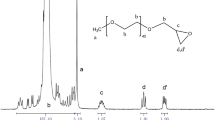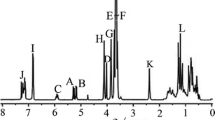Abstract
When polycation and polyanion with high density of charge are directly mixed at middle component ratios to prepare interpolymer complex, aggregation and sediment are often encountered. In this work, a novel randomly branched polycation, PTEE, with high density of charge and lots of big hydrophilic groups of 2-hydroxyl-3-ethoxyprop-1-yl, was synthesized and its interpolymer complex with PAA was prepared by direct mixing to examine the effect of big hydrophilic groups on complex formation and stability. The structures of PTEE and its precursor and complex were characterized by 1HNMR and FT-IR. PTEE/PAA complex particle size, size distribution and stability were measured. Results showed that 2-hydroxyl-3-ethoxyprop-1-yl groups obviously improved complex formation and small complex particles were obtained. The largest mean particle size of PTEE/PAA complex was 320 nm, far smaller than the 20,000 nm of the reference polycation without big hydrophylic groups. Results also showed, different from the contribution to complex formation, big hydrophilic groups had no obvious contribution to static standing stability.










Similar content being viewed by others
References
An N, Wang XH, Li YX, Zhang L, Lu ZY, Sun JQ (2019) Healable and mechanically super-strong polymeric composites derived from hydrogen-bonded polymeric complexes. Adv Mater 31:1904882
Atanase LI, Riess G (2019) Micellization of poly(2-vinylpyrridine)-b-poly(cyclohexyl methacrylate) (P2VP-b-PCHMA) block copolymers and their interpolymer complex formation in non-aqueous medium. J Colloid Interface Sci 549:171–178
Nekrasova TN, Kirila TY, Kurlykin MP, Ten’kovtsev AV, Filippov AP (2021) Interpolymer complexes of star-shaped copolymers of polyoxazoline with the calixarene core and linear polyacids in solution. Polym Sci Ser B 63(2):116–125
van Lente JJ, Claessens MMAE, Lindhoud S (2019) Charge-based separation of proteins using polyelectrolyte complexes as models for membraneless organelles. Biomacromol 20:3696–3703
Machinskaya AE, Vasilevskaya VV (2016) The formation of interpolymer complexes in mixtures of weak polyelectrolytes. Polym Sci Ser A 58(4):606–612
Rumyantsev M, Savinova MV (2018) Steady-shear rheology and activation thermodynamics of the interpolymer complex between nonionic polymeric surfactant and hydrophobically modified polyacrylic acid in propylene glycol-water mixture. Polym Bull 75(1):17–30
Payne ME, Lou YY, Zhang XD, Sahiner N, Sandoval NR, Shantz DF, Grayson SM (2020) Comparison of cross-linked branched and linear poly(ethylene imine) microgel microstructures and their impact in antimicrobial behavior, copper chelation, and carbon dioxide capture. ACS Appl Polym Mater 2(2):826–836
Bandehali S, Moghadassi A, Parvizian F, Zhang YT, Hosseini SM, Shen JN (2020) New mixed matrix PEI nanofiltration membrane decorated by glycidyl-POSS functionalized graphene oxide nanoplates with enhanced separation and antifouling behaviour: heavy metal ions removal. Sep Purif Technol 242:116745
Chen ZH, Han XY, Lin ZY, Fan YL, Shi GY, Zhang SQ, Zhang M (2019) Facile reflux synthesis of polyethyleneimine-capped fluorescent carbon dots for sequential bioassays toward Cu2+/H2S and its application for a logic system. Biotechnol Appl Biochem 66(3):426–433
Kovacevic D, Borkovic S, Pozar J (2007) The influence of ionic strength, electrolyte type and preparation procedure on formation of weak polyelectrolyte complexes. Colloid Surf A 302:107–112
Ushimaru K, Morita T, Fukuoka T (2020) A bio-based adhesive composed of polyelectrolyte complexes of lignosulfonate and cationic polyelectrolytes. J Wood Chem Technol 40:172–177
Lall A, Tamo AK, Doench I, David L, de Oliveira PN, Gorzelanny C, Osorio-Madrazo A (2020) Nanoparticles and colloidal hydrogels of chitosan-caseinate polyelectrolyte complexes for drug-controlled release applications. Int J Mol Sci 21(16):5602
Anurova MN, Demina NB, Bakhrushina EO (2018) Physicochemical and technical studies of an interpolymer complex of polymethyacrylic acid and polyethylene glycol as the base for creating matrix systems. Pharm Chem J 52(7):635–640
Orazzhanova LK, Kassymova ZS, Mussabayeva BK, Klivenko AN (2020) Soil structuring in the presence of the chitosan-polyacrylic acid interpolymer complex. Eurasian Soil Sci 53(12):1773–1781
Nakan U, Mun GA, Rakhmetullayeva RK, Tolkyn B, Bieerkehazhi S, Yeligbayeva GZ, Negim E (2020) Thermosensitive N-isopropylacrylamide -CO2-hydroxyethyl acrylate hydrogels interactions with poly(acrylic acid) and surfactants. Polym Advan Technol 32(7):2676–2681
Szabo A, Szanka I, Tolnai G, Szarka G, Ivan B (2017) LCST-type thermoresponsive behaviour of interpolymer complexes of well-defined poly(poly(ethylene glycol) methacrylate)s and poly(acrylic acid) synthesized by ATRP. Polymer 111:61–66
Wu CB, Hao JY, Deng XM, Liu Y (2007) A novel potential cationic polymeric gene vector containing hydroxy groups and all grades of amino groups. J Appl Polym Sci 105(3):1533–1542
Acknowledgements
This work was supported by Scientific and Technological Project of Jiangxi Province Education Department (GJJ161063).
Author information
Authors and Affiliations
Corresponding author
Additional information
Publisher's Note
Springer Nature remains neutral with regard to jurisdictional claims in published maps and institutional affiliations.
Rights and permissions
About this article
Cite this article
Wu, CB., Hao, JY., Liu, LJ. et al. Synthesis and interpolymer complexation of a novel polycation with 2-hydroxyl-3-ethoxyprop-1-yl groups, high density of charge and excellent proton buffering capability. Polym. Bull. 80, 2665–2680 (2023). https://doi.org/10.1007/s00289-022-04180-8
Received:
Revised:
Accepted:
Published:
Issue Date:
DOI: https://doi.org/10.1007/s00289-022-04180-8




